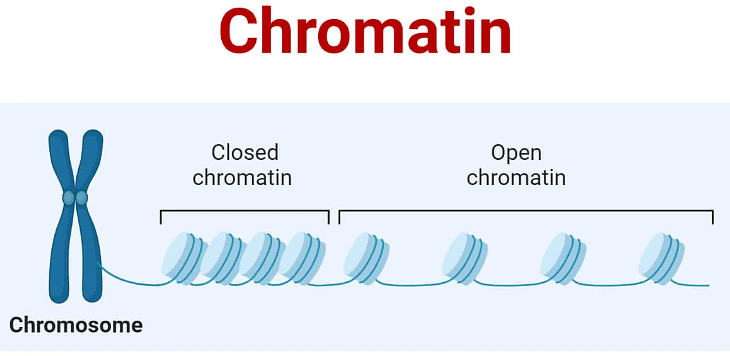Organization of Chromatin | Zoology Optional Notes for UPSC PDF Download
Introduction
Chromatin is a complex structure found in eukaryotic cells, comprising RNA, DNA, and proteins. Its primary function is to package DNA molecules in a dense, compact shape, preventing tangling and strengthening DNA during cell division.

Role in Cell Division
During mitosis and meiosis, chromatin aids in separating chromosomes during anaphase. The term "chromosome" originates from the Greek words chroma (color) and soma (body) due to their affinity for specific dyes. Euchromatin, lightly stained and less condensed, coexists with darkly stained, highly condensed heterochromatin.
Chromatin Organization
A. DNA Wrapping Around Histones
- DNA wraps around histone proteins, forming a beads-on-a-string structure.
- Histones further organize into 30nm fiber-like arrays, especially in heterochromatin.
- Higher DNA supercoiling of the 30nm fiber creates metaphase chromosomes.
B. Nucleosome Arrays and Chromatin Structure
- Binding of H1 stabilizes higher-order chromatin structure.
- Addition of high salt concentrations results in 30nm fibers of nucleosomal DNA.
- In vivo observation reveals additional levels of DNA compaction.
C. Packaging of DNA into Chromosomes
- Two models: solenoid and zig-zag, describe different arrangements of nucleosomes.
- Solenoid model involves a helical path of ~11nm, with DNA moving between nucleosomes.
- Zig-zag model, based on nucleosome patterns, features more accessible entry and exit points.
Nuclear Scaffold
Two classes of proteins, Topoisomerase 2 and SMC proteins, play crucial roles in the nuclear scaffold. Topo 2 isolates DNA loops, while SMC proteins contribute to chromosomal condensation after duplication.
Chromatin Structure during the Cell Cycle
During interphase, chromatin restricts access to DNA and RNA polymerases. Euchromatin, with loosely packed genes, contrasts with tightly packed heterochromatin. Epigenetic alterations, including acetylation and methylation, influence chromatin structure.
Eukaryotic Chromosome in Cell Division
Chromatin undergoes remodeling, histone modifications, and incorporation of variants during cell division. Remodeling enzymes regulate transcription, recombination, and repair activities. Histone modifications impact chromatin availability and compaction.
Techniques for Chromatin Analysis
A. Dnase1 Hypersensitivity
- Genomic wide sequencing with Dnase1 cleavage.
- Effective nuclease activity achieved with EDTA or EGTA.
B. DNA Footprinting
- Identifies DNA-binding proteins in specific regions.
- Inhibitory detection assay using PAGE electrophoresis.
- Methods include gene amplification, labeled DNA, immunoprecipitation, DNA modification, and gel electrophoresis.
C. Chromatin Immunoprecipitation Sequencing
- Analyzes protein-DNA interactions and identifies binding sites.
Microscopic Observation
Microscopic observation reveals heterochromatin and euchromatin states in nondividing cells. Heterochromatin contains inactive genes, while euchromatin is transcriptionally active.
Eukaryotic Chromosome Structure
Details the structure of eukaryotic chromosomes, including the centromere, sister chromatids, and unique chromosomal complements in different species.
Recent Findings and Clinical Implications
Highlights recent findings on transcription mediated by the glucocorticoid receptor and its potential role in treating diseases.
Advantages and Disadvantages of Techniques
A. Advantages
- Precise identification of ligand binding regions.
- Commercial affordability.
- Effective separation of DNA fragments.
B. Disadvantages
- Conventional, time-consuming, and labor-intensive.
- Low banding resolution.
- Hazards associated with radioactivity.
Conclusion
Despite its crucial role in cellular activities, defective chromatin remodeling contributes to various human disorders. Understanding chromatin structure may unlock molecular depth and aid in developing therapeutic interventions for diseases.
|
181 videos|351 docs
|
FAQs on Organization of Chromatin - Zoology Optional Notes for UPSC
| 1. What is the role of chromatin in cell division? |  |
| 2. How is chromatin organized in the nucleus? |  |
| 3. How does chromatin structure change during the cell cycle? |  |
| 4. What are some techniques used for chromatin analysis? |  |
| 5. What are the recent findings and clinical implications of chromatin organization? |  |





















